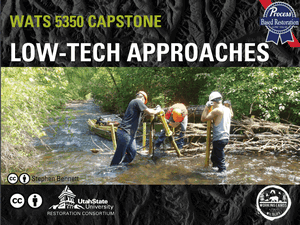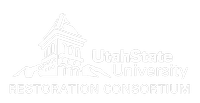Introduction to Low-Tech PBR of Riverscapes
Introduction
We first introduced low-tech process-based restoration (PBR) by defining it and talking about:
- the primary impairment it addresses: structurally-starved riverscapes
- the primary processes promoted with low-tech PBR: wood accumulation and beaver dam activity
- the typically structures used to reverse structural starvation
Lectures
Please watch this series of lectures in the playlist below.
- The first lecture is a ~17 minute talk I had Mark Beardsley’s give on inviting us to “reimgine what riverscapes could be”. In it he refers to Colin Thorne’s work and lecture, which I am not asking you to watch, but you may find interesting.
- The second lecture is a ~ 40 minute talk from me introducing you to LTPBR. I recorded this as a more concise overview of what is covered in a combination of Jeremy Maestas’ Background Talk, my Scope of Problem talk, Jeremy’s Broad Umbrella of Low-Tech Restoration, Steve Bennet’s Talk on PALS, and Scott Shahveridan’s Talk on BDAs.
- The third lecture in the a ~ 40 minute talk from me covering some fundamental Principles.
- The final lecture is a ~ 20 minute talk from award winning Author and Journalist Ben Goldfarb to get you up to speed on beaver history. If you want more, you may find Nick Bouwes’ talk on Beaver ecology, feedbacks and why beaver build dams quite helpful.
Module 4 - Low-Tech PBR Intro Playlist
1 hour 56 minutes
Reading
For this module, please read from the course text) (note: free PDF available below):
- Chapter 1 in its entirety (p 27-50) including the appendices.
- Chapter 2 in its entirety (p 57-82) including the appendices.
- Skim Chapter 4 to familiarize your self with PALS and BDAs (p 145-207) including the appendices. We will revisit this in more detail during design.
- Chapters 1, 2 & 4 of Wheaton J.M., Bennett S.N., Bouwes, N., Maestas J.D. and Shahverdian S.M. (Editors). 2019. Low-Tech Process-Based Restoration of Riverscapes: Design Manual. Version 1.0. Utah State University Restoration Consortium. Logan, UT. 286 pp. DOI: 10.13140/RG.2.2.19590.63049/2.
Other Resources
Course Reference - WATS 5620
For reference, also see the online, self-paced materials associated with the popular 2020 Virtual Workshop. Graduate students and professionals take a more in-depth version of this in the 1 credit, WATS 5620:
Note that 3 of the 4 lectures in your assigned lecture play list are from the 14 we cover in the WATS 5620 class.
Associated Exercises
For the workshops and WATS 5620 class, we have participants do two exercises:
Past Years’ Resources
2020 Content
In Fall, 2019 WATS 5340, we introduced the topic of low-tech PBR in the Principles topics. As such, we didn’t cover it again in the Spring (WATS 5350), but we draw your attention to it here. We did not give an introduction to the different types of low-tech treatments, and we provide that lecture here:
Low-Tech Structures
 Having previously covered principles, we work through the diversity of low-tech approaches and structure types in this lecture so you have a handle on what you’re going to be using in your designs.
Having previously covered principles, we work through the diversity of low-tech approaches and structure types in this lecture so you have a handle on what you’re going to be using in your designs.
This talk is elaborated in Chapter 1 & Chapter 4 of design manual.
Recorded Lecture
2019 Content
This introduction corresponds to the first two chapters from the Low-Tech PBR Design Manual.
Principles
We then transitioned into the bigger background problem and scope, and the core principles of low-tech PBR:



 Module 1 - Intro to LTPBR
Module 1 - Intro to LTPBR